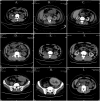Two novel AGXT mutations identified in primary hyperoxaluria type-1 and distinct morphological and structural difference in kidney stones
- PMID: 27644547
- PMCID: PMC5028881
- DOI: 10.1038/srep33652
Two novel AGXT mutations identified in primary hyperoxaluria type-1 and distinct morphological and structural difference in kidney stones
Abstract
Primary hyperoxaluria type 1 (PH1) is a rare genetic disease characterized by excessive oxalate accumulation in plasma and urine, resulting in various phenotypes because of allelic and clinical heterogeneity. This study aimed to detect disease-associated genetic mutations in three PH1 patients in a Chinese family. All AGXT exons and 3 common polymorphisms which might synergistically interact with mutations, including P11L, I340 M and IVSI+74 bp were analyzed by direct sequencing in all family members. It demonstrated that in each of three patients, a previously reported nonsense mutation p.R333(*) was in cis with a novel missense mutation p.M49L in the minor allele characterized by the polymorphism of 74-bp duplication in intron 1, while the other novel missense mutation p.N72I was in trans with both p.R333(*) and P.M49L in the major allele. Kidney stones from two sibling patients were also observed though stereomicroscopic examination and scanning electron microscopy. Distinct morphological and inner-structure differences in calculi were noticed, suggesting clinical heterozygosity of PH1 to a certain extent. In brief, two novel missense mutations were identified probably in association with PH1, a finding which should provide an accurate tool for prenatal diagnosis, genetic counseling and screening for potential presymptomatic individuals.
Figures




Similar articles
-
Mutation spectrum of primary hyperoxaluria type 1 in Tunisia: implication for diagnosis in North Africa.Gene. 2013 Sep 15;527(1):316-20. doi: 10.1016/j.gene.2013.06.023. Epub 2013 Jun 25. Gene. 2013. PMID: 23810941
-
Identification of a novel AGXT gene mutation in primary hyperoxaluria after kidney transplantation failure.Transpl Immunol. 2016 Nov;39:60-65. doi: 10.1016/j.trim.2016.08.008. Epub 2016 Aug 25. Transpl Immunol. 2016. PMID: 27568336
-
A novel mutation in the AGXT gene causing primary hyperoxaluria type I: genotype-phenotype correlation.J Genet. 2016 Sep;95(3):659-66. doi: 10.1007/s12041-016-0676-4. J Genet. 2016. PMID: 27659337
-
Updated Genetic Testing of Primary Hyperoxaluria Type 1 in a Chinese Population: Results from a Single Center Study and a Systematic Review.Curr Med Sci. 2018 Oct;38(5):749-757. doi: 10.1007/s11596-018-1941-y. Epub 2018 Oct 20. Curr Med Sci. 2018. PMID: 30341509
-
Primary hyperoxaluria type 1: update and additional mutation analysis of the AGXT gene.Hum Mutat. 2009 Jun;30(6):910-7. doi: 10.1002/humu.21021. Hum Mutat. 2009. PMID: 19479957 Review.
Cited by
-
Mutation Characteristics of Primary Hyperoxaluria in the Chinese Population and Current International Diagnosis and Treatment Status.Kidney Dis (Basel). 2024 Jun 17;10(4):313-326. doi: 10.1159/000539516. eCollection 2024 Aug. Kidney Dis (Basel). 2024. PMID: 39131880 Free PMC article. Review.
-
Infant primary hyperoxaluria type 1: A case report and literature review.Zhong Nan Da Xue Xue Bao Yi Xue Ban. 2024 Jun 28;49(6):856-862. doi: 10.11817/j.issn.1672-7347.2024.230582. Zhong Nan Da Xue Xue Bao Yi Xue Ban. 2024. PMID: 39311781 Free PMC article. Review. Chinese, English.
-
Four novel variants identified in primary hyperoxaluria and genotypic and phenotypic analysis in 21 Chinese patients.Front Genet. 2023 Apr 17;14:1124745. doi: 10.3389/fgene.2023.1124745. eCollection 2023. Front Genet. 2023. PMID: 37139236 Free PMC article.
-
Intrafamilial Disease Heterogeneity in Primary Hyperoxaluria Type 1.Kidney Int Rep. 2024 Jul 31;9(10):3006-3015. doi: 10.1016/j.ekir.2024.07.026. eCollection 2024 Oct. Kidney Int Rep. 2024. PMID: 39430166 Free PMC article.
-
Primary hyperoxaluria: the adult nephrologist's point of view.Clin Kidney J. 2022 May 17;15(Suppl 1):i29-i32. doi: 10.1093/ckj/sfac068. eCollection 2022 May. Clin Kidney J. 2022. PMID: 35711295 Free PMC article. Review.
References
-
- Kanoun H. et al.. A double mutation in AGXT gene in families with primary hyperoxaluria type 1. Gene. 531, 451–456 (2013). - PubMed
-
- Cregeen D. P., Williams E. L., Hulton S. & Rumsby G. Molecular analysis of the glyoxylate reductase (GRHPR) gene and description of mutations underlying primary hyperoxaluria type 2. Hum Mutat. 22, 497–506 (2003). - PubMed
Publication types
MeSH terms
Substances
Supplementary concepts
LinkOut - more resources
Full Text Sources
Other Literature Sources
Medical

